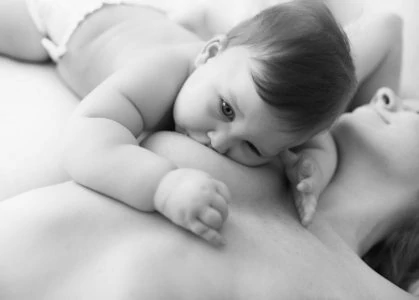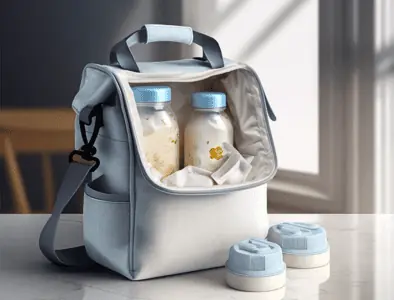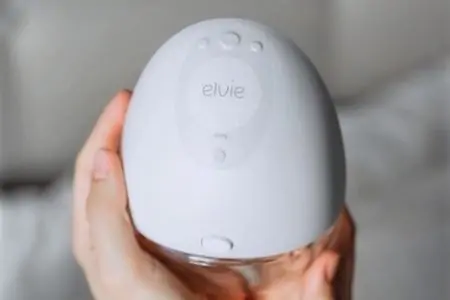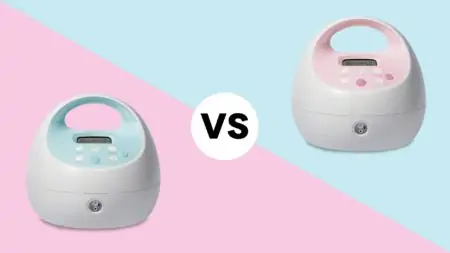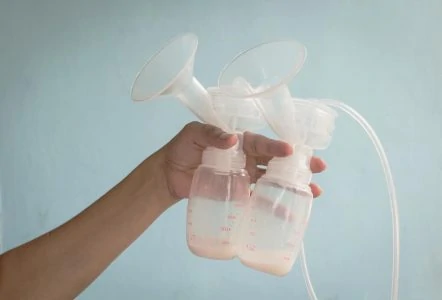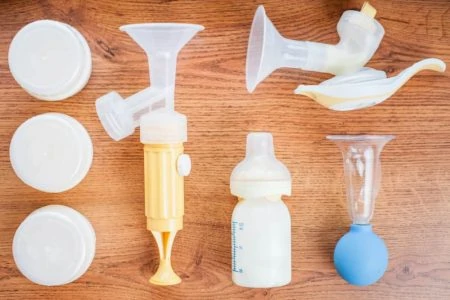Breastfeeding is a beautiful bonding experience, but let’s be honest; it shouldn’t curl your toes in pain. If you are dealing with the sharp sting of cracked or bleeding nipples, you aren’t alone.
Research suggests over 30% of new mothers experience nipple damage in the first month postpartum (1). The pain can be intense enough to make you want to quit nursing entirely.
Don’t give up just yet. We are here to help you identify the root cause, heal your skin, and get back to comfortable feedings. Here is everything you need to know about fixing cracked nipples.
Key Takeaways
- Root Causes: The most common culprits are a shallow latch, tongue ties, incorrect flange size, or yeast infections like thrush.
- Symptoms: Look for fissures, scabbing, bleeding, or shooting pain during latch-on.
- Effective Treatments: Silver nursing cups, moist wound healing (lanolin or hydrogel pads), and saline rinses speed up recovery.
- Medical Help: See a doctor if you suspect an infection (mastitis) or if deep cracks don’t heal after a few days of treatment.
What Causes Cracked Nipples?
Cracked nipples are a sign that something mechanical isn’t working during your feeding sessions. While some tenderness is normal in the first week, open skin means you need to adjust your technique or gear.
Here are the most common reasons your nipples might be cracking:
1. A Shallow Latch
This is the number one offender. A “shallow latch” happens when your baby sucks only on the nipple rather than taking a large mouthful of breast tissue. Ideally, the nipple should be deep in the baby’s mouth near the soft palate.
If the latch is shallow, your nipple hits the hard palate or rubs against the gums. This constant friction acts like sandpaper on your skin and leads to cracks, blisters, and bleeding very quickly.
2. Tongue-Tie (Ankyloglossia)
Sometimes a baby wants to latch deeply but physically can’t. A tongue-tie restricts the tongue’s movement (2). The baby compensates by chewing or biting down to hold the nipple in place.
This condition often causes misshapen nipples (looking like a slanted lipstick) after feedings and severe pain for the mother.
3. Incorrect Breast Pump Flanges
Your breast pump should not hurt. If you see rubbing along the sides of the tunnel or if your areola is being pulled in too far, your flange (shield) size is likely wrong.
Pumping with the wrong size creates friction similar to a bad latch. High suction settings can also cause edema and skin damage over time.
4. Thrush (Yeast Infection)
Thrush is a fungal infection that thrives in warm, moist environments (3). It can cause skin to become flaky, shiny, cracked, and intensely painful.
If you have shooting pains in the breast or itchy, cracked nipples that don’t heal with normal adjustments, check your baby’s mouth for white patches.
5. Dermatitis or Eczema
If you have a history of sensitive skin, eczema, or psoriasis, your nipples are not exempt. Contact dermatitis can flare up due to laundry detergents, soaps, or lotions. This leaves the skin dry, itchy, and prone to cracking when stretched during nursing.
6. Sudden Bottle Introduction
Babies use different mouth muscles to drink from a baby bottle than they do at the breast. If you introduce a bottle, your baby might try to use that same “straw-sipping” technique on your breast.
This nipple confusion usually results in the baby clamping down on the nipple to control the flow, causing immediate trauma.
7. Tight Nursing Bras
Your nursing bras should support you, not crush you. Bras that are too tight trap moisture and rub against sensitive tissue. This constant friction weakens the skin barrier and makes cracking more likely during feeds.
8. Engorgement
When your breasts are overly full (engorged), the nipple flattens out. It becomes like trying to latch onto a tight balloon. The baby will struggle to get a grip and often ends up nipping at the end of the nipple, causing instant damage.
9. Damp Nursing Pads
While leaking is normal, leaving wet pads against your skin for hours is dangerous. The moisture causes maceration (softening of the skin), making it weak and easily broken. It also creates the perfect breeding ground for bacteria and yeast.
10. Harsh Hygiene Products
Your nipples produce natural oils to protect themselves. If you scrub them with harsh soaps or use alcohol-based products, you strip away this natural barrier. The result is dry, brittle skin that cracks easily.
Symptoms of Cracked Nipples
You might feel the pain before you see the damage. Postpartum bodies go through many changes, so it helps to know exactly what to look for.
Common symptoms include (4):
- Visible fissures: These look like paper cuts or deep cracks across the nipple face or base.
- Bleeding: You may see blood in the baby’s spit-up or on your pump parts.
- Scabbing: Yellow or dark crusts forming over the nipple.
- Distortion: Nipples looking pinched, creased, or white after feeding.
- Extreme pain: Toe-curling pain upon latch that may or may not subside during the feed.
If you are unsure, consult a lactation consultant. They can visualize the issue and help diagnose the mechanical cause.
If your nipples are cracked and bleeding, you may be worried about your baby ingesting blood when feeding. This will not harm your baby, though if they spit up, it may look pink or red. Also, if you are pumping with cracked, bleeding nipples, it takes only a few drops of blood to make the pumped milk look pretty red. You can still safely feed this milk to your baby.
Editor's Note:
Michelle Roth, BA, IBCLCHow to Treat Cracked Nipples
Healing requires a two-pronged approach: fix the cause (like the latch) and treat the wound.
Here are 12 proven remedies to soothe the pain and speed up recovery.
1. Wet Wound Healing (Lanolin)
The “air it out” advice is outdated for deep cracks. Current medical advice supports “moist wound healing.” This prevents scabs from forming, which would just get ripped off during the next feeding.
Use a highly purified medical-grade lanolin nipple cream. It creates a breathable barrier that keeps the skin supple while it knits back together (5).
2. Use Silver Nursing Cups
Silver nursing cups are small cups made of 925 sterling silver that fit over your nipples inside your bra. Silver has natural antimicrobial, anti-inflammatory, and antifungal properties.
Many moms swear by these because they physically protect the nipple from friction with clothing and create a healing environment using your own breast milk.
3. Apply Fresh Breast Milk
Your body produces the cure! Breast milk contains antibodies and epidermal growth factors that repair skin.
After feeding, express a few drops of milk, gently rub it into the crack, and let it dry before applying your cream or cups. It is safe, free, and incredibly effective (6).
4. Salt Water Rinse (Saline)
To prevent infection and clean deep cracks, use a saline rinse. Mix 1/2 teaspoon of non-iodized salt into one cup of warm water.
Soak your nipples in this solution for a minute or dab it on gently. Rinse with fresh water afterward to prevent the salt from drying out your skin. This mimics the saline used in hospitals for wound care.
5. Hydrogel Pads
For immediate cooling relief, try hydrogel pads. These are soothing, gel-filled dressings that sit on the nipple. They provide instant pain relief and keep the wound moist.
Safety Tip
6. Adjust Your Latch
You must fix the mechanical issue, or the cracks will return. Use the “flipple” technique or an asymmetric latch to get more breast tissue into the baby’s mouth.
Ideally, the baby’s chin should touch your breast first, and their nose should be clear. If it hurts, break the suction with your finger and try again. Never “tough it out” through a bad latch.
7. Switch Positions
Changing your hold changes where the pressure falls on your nipple. If you usually do the cradle hold, try the football hold or the laid-back position. This rotates the baby’s mouth and gives the sore spot on your nipple a break.
Sometimes, having your baby’s mouth in a different position on the breast makes feedings more bearable — even with nipple pain. For instance, if you always use the cradle hold, consider lying on your side or using the football hold instead.
Editor's Note:
Michelle Roth, BA, IBCLC8. Check Your Flange Size
If pumping caused the damage, remeasure your nipples. Your nipple should move freely inside the tunnel without rubbing the sides.
Many pumps come with 24mm or 28mm shields, but many women actually need 17mm, 19mm, or 21mm. Using the correct size can stop the damage immediately.
9. OTC Pain Relief
It is hard to relax for a let-down when you are in pain. Anti-inflammatories like Ibuprofen (Advil/Motrin) or Acetaminophen (Tylenol) are generally considered safe for breastfeeding mothers (7). Taking a dose about 30 minutes before feeding can help take the edge off.
10. Use Breathable Pads
Avoid plastic-lined disposable nursing pads if you have damaged skin. The plastic traps heat and moisture.
Switch to reusable pads made of wool, bamboo, or cotton. These materials breathe better. Change them the moment they get damp to keep bacteria away from your open wounds.
11. Give the Breast a Break
If one side is bleeding severely, it is okay to pump that side gently for 24 hours to let it heal. You can feed the baby on the “good” side and offer the expressed milk from the “bad” side in a bottle or cup. This brief holiday can give the skin time to close up.
12. See a Professional
If you have tried home remedies for a few days with no improvement, you need an expert. An IBCLC (International Board Certified Lactation Consultant) can assess oral ties, check for infections, and help you position the baby correctly.
Pro Tip
When to Visit a Doctor
Warning
If bacteria enters the milk ducts via a crack, it can lead to Mastitis (8). This is a serious infection that requires antibiotics.
Call your doctor immediately if you experience:
- A fever over 101.3°F (38.5°C).
- Flu-like chills and body aches.
- A red, warm wedge-shaped area on the breast.
- Pus or green/yellow discharge from the crack.
- Deep breast pain that does not stop after feeding.
Hygiene for Healing
You don’t need a complex cleaning routine. In fact, over-washing is harmful.
Rinse your breasts with warm water during your daily shower. Avoid soap on the nipple itself. If you are using ointments, you generally do not need to scrub them off before feeding (check the label on your lanolin or balm).
Hand hygiene is critical. Always wash your hands before touching your breasts or handling pump parts to prevent introducing staph bacteria to the open cracks.
FAQs
In Conclusion
Cracked nipples are a painful hurdle, but they don’t have to mark the end of your breastfeeding journey. By adjusting your latch, using the right healing aids, and being gentle with yourself, you can overcome this.Remember, you are learning a new skill alongside your baby. If the pain persists, reach out to a professional. You deserve to feed your baby in comfort.
